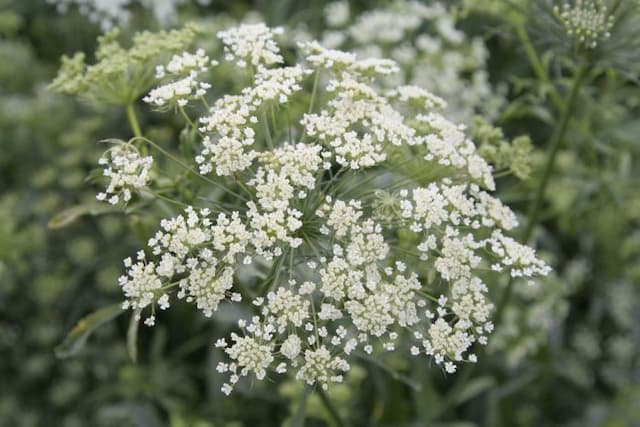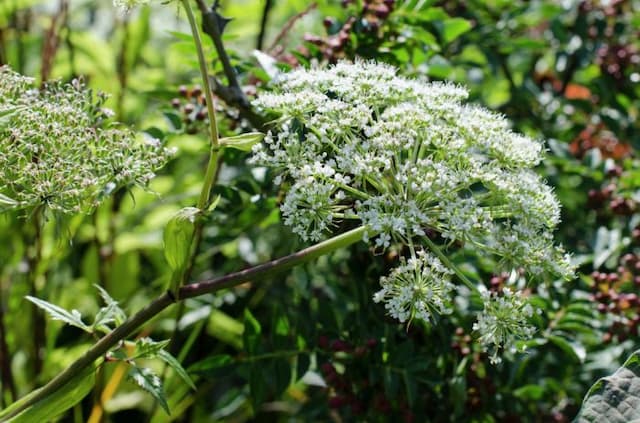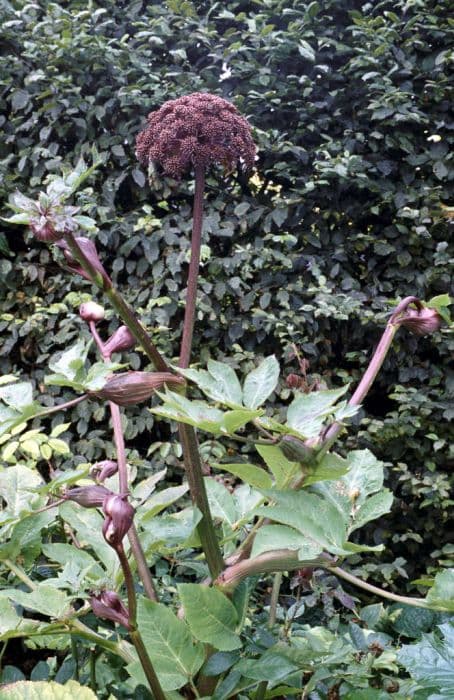Baltic Parsley Cenolophium denudatum

ABOUT
Cenolophium denudatum, commonly known as Baltic parsley, is an herbaceous perennial plant known for its elegant, dainty appearance. The plant features fine, deeply divided leaves that are feather-like, creating a delicate texture. These leaves are typically bright green, adding a vibrant backdrop to the subtle blooms it produces. During the blooming period, Baltic parsley exhibits small, white flowers that are clustered together in umbrella-like groups known as umbels. Each individual flower is tiny and inconspicuous, but collectively they form a cloud of white that floats above the foliage, giving the plant an airy, frothy look. When in flower, these clusters create a contrast with the green leaves and can attract a variety of pollinators to the garden. The plant's overall form is reminiscent of some traditional parsley leaves in shape, though it does not serve as a culinary herb. Its foliage remains attractive throughout the growing season, and the flowers typically appear in the summer months, persisting for several weeks and adding visual interest to garden borders or wildflower gardens. In terms of maintenance, Baltic parsley is known for being tolerant of various soil conditions and is relatively easy to care for, making it a desirable addition for both novice and experienced gardeners looking to add a touch of soft texture and light floral accents to their planting schemes.
About this plant
 Names
NamesFamily
Apiaceae
Synonyms
Baltic Parsley, Denuded Cenolophium
Common names
Cenolophium denudatum
 Toxicity
ToxicityTo humans
The plant Cenolophium denudatum, commonly known as Baltic parsley, does not have a well-documented profile of toxicity to humans. There are no widespread reports or specific symptoms associated with poisoning from this plant in humans, suggesting that it might not be significantly toxic. However, as with any plant, individual allergic reactions or sensitivities are possible. Ingesting any part of the plant without proper knowledge of its edibility may pose a risk of gastrointestinal discomfort or other adverse effects due to personal allergies or the presence of naturally occurring plant compounds.
To pets
The plant Cenolophium denudatum, commonly known as Baltic parsley, is not widely recognized as a toxic plant to pets such as dogs and cats. There is limited information available about its toxicity in domestic animals, which implies that it may not be highly poisonous. Nevertheless, ingestion of plants by pets can sometimes lead to mild gastrointestinal upset, such as vomiting or diarrhea, particularly if the pet is not accustomed to eating that plant or has a sensitivity to it. Pet owners should always exercise caution and consult with a veterinarian if their animals consume any part of an unfamiliar plant.
 Characteristics
CharacteristicsLife cycle
Perennials
Foliage type
Deciduous
Color of leaves
Green
Flower color
White
Height
3 feet (0.91 meters)
Spread
2 feet (0.61 meters)
Plant type
Herb
Hardiness zones
5
Native area
Caucasus
Benefits
 General Benefits
General Benefits- Attracts Pollinators: Cenolophium denudatum, commonly known as Baltic parsley, is known for its ability to attract beneficial insects including bees and butterflies which are essential for pollination.
- Aesthetic Appeal: Its delicate fern-like foliage and white umbel flowers contribute to the aesthetic beauty of gardens and landscapes.
- Drought Resistance: Once established, it has good drought tolerance, making it suitable for xeriscaping and low-water garden designs.
- Herbaceous Perennial: Being a perennial, it regrows every spring from the same roots, reducing the need for replanting annually.
- Easy to Grow: Baltic parsley is relatively easy to grow and can thrive in a variety of soil conditions with minimal care required.
- Wildlife Habitat: The plant provides shelter and food for wildlife, thereby supporting local biodiversity.
- Culinary Use: Though not widely known as a culinary herb, the leaves can be used in cooking and have a flavor similar to conventional parsley.
 Medical Properties
Medical PropertiesThis plant is not used for medical purposes.
 Air-purifying Qualities
Air-purifying QualitiesThis plant is not specifically known for air purifying qualities.
 Other Uses
Other Uses- Cenolophium denudatum, commonly known as Baltic parsley, can be used in natural dye production, yielding subtle hues depending on the mordant used.
- Its sturdy stems are sometimes employed in basket weaving or as a structural element in naturalistic craft projects.
- The seed heads of Baltic parsley add an ornamental touch when used in dry flower arrangements, maintaining shape and form for extended periods.
- Gardeners may use the dried, hollow stems as natural conduits for watering or to support small climbing plants in garden beds.
- Baltic parsley is known to attract beneficial insects, making it a valuable addition to companion planting strategies in the vegetable garden.
- The dried foliage can be incorporated into homemade potpourris or as a decorative element in wreaths and other dried floral crafts.
- It serves as a larval food source for some species of butterflies, contributing to the ecological diversity of a garden.
- The plant can be used as part of a natural insect repellent strategy when combined with other deterrent plants in a border around outdoor sitting areas.
- Including Cenolophium denudatum in a rain garden assists in water management efforts, as it tolerates and thrives in wet conditions.
- Its contrasting dark stems and light flowers can be used in monochromatic garden design to provide visual depth and interest.
Interesting Facts
 Feng Shui
Feng ShuiThe Baltic Parsley is not used in Feng Shui practice.
 Zodiac Sign Compitability
Zodiac Sign CompitabilityThe Baltic Parsley is not used in astrology practice.
 Plant Symbolism
Plant Symbolism- **Uniqueness** - As Cenolophium denudatum, commonly known as Baltic parsley, is not a widely recognized plant in traditional symbolism, it stands to represent uniqueness or uncommon beauty.
- **Harmony with Nature** - Given its natural habitat and effortless growth in wild settings, it could be seen as a symbol of harmony with nature.
- **Simplicity** - The delicate and uncomplicated structure of the plant might be associated with simplicity and modesty.
- **Adaptability** - Being capable of thriving in various soil types, the Baltic parsley suggests adaptability and resilience.
 Water
WaterThe Baltic parsley should be watered deeply and regularly, especially during dry spells. It is essential to keep the soil consistently moist but not waterlogged. Water the plant with approximately 1 gallon of water per week, adjusting for rainfall and temperatures. During the hottest part of the summer, you may need to water more frequently, possibly twice a week, to maintain soil moisture. Overhead watering is not recommended as it can promote foliar diseases; instead, water at the base of the plant to keep the leaves dry.
 Light
LightBaltic parsley thrives best in full sun to partial shade. Planting it in a location that receives at least six hours of sunlight per day will ensure optimal growth and flowering. However, in hotter climates, some afternoon shade is beneficial to prevent scorching of the leaves.
 Temperature
TemperatureBaltic parsley performs best in temperatures between 50 and 75 degrees Fahrenheit but is hardy in a range of about 20 to 85 degrees Fahrenheit. The plant can survive light frost but should be protected if temperatures are expected to drop below 20 degrees Fahrenheit. Preferably, you should ensure the plant is situated in an area that doesn't experience extreme temperature fluctuations for best growth.
 Pruning
PruningPrune Baltic parsley to remove spent flowers and encourage a second bloom. Light pruning can also be done in early spring to shape the plant and promote bushier growth. The best time for pruning is after the first flowering period has finished, typically in late summer or early autumn.
 Cleaning
CleaningAs needed
 Soil
SoilBaltic Parsley (Cenolophium denudatum) thrives best in a soil mix that has good drainage, is rich in organic matter, and is moderately fertile. A mix containing garden loam, peat, and perlite or sand in equal parts would be ideal. The optimum soil pH level for Baltic Parsley is between 6.0 and 7.0, slightly acidic to neutral.
 Repotting
RepottingBaltic Parsley does not typically require frequent repotting. It can be repotted once it outgrows its current container, which is approximately every 2-3 years, to refresh the soil and allow room for further growth.
 Humidity & Misting
Humidity & MistingBaltic Parsley prefers moderate humidity levels but is quite adaptable to various conditions. As a hardy perennial, it doesn’t require the high humidity that some more tropical plants do.
 Suitable locations
Suitable locationsIndoor
Ensure bright light and water when topsoil feels dry.
Outdoor
Plant in full sun to partial shade in well-draining soil.
Hardiness zone
5-9 USDA
 Life cycle
Life cycleCenolophium denudatum, commonly known as Baltic Parsley, begins its life cycle as a seed, which, when sown, will germinate in a moist, well-drained medium. Upon germination, seedlings establish a small rosette of ferny, pinnate foliage. As the plant matures, it develops a stronger root system and more substantial foliage. In its second year, Baltic Parsley sends up tall, sturdy stems topped with umbels of white flowers in mid to late summer, which are attractive to a variety of pollinators. After blooming and subsequent pollination, the plant sets seed, which can be collected for propagation or allowed to self-sow in the garden. With the arrival of autumn, Baltic Parsley's above-ground parts die back, and the plant enters a dormant phase until the next spring, completing its perennial life cycle.
 Propogation
PropogationPropogation time
Spring-Early Summer
Propogation: Baltic Parsley (Cenolophium denudatum) can be propagated by seed sown in the spring. The most popular method involves surface sowing the seeds as they need light to germinate. To begin with, prepare a seed-starting mix in a flat or tray and lightly press the seeds into the surface without covering them, as they need light to germinate. The tray should then be placed in a warm area with temperatures around 65 to 70 degrees Fahrenheit (18 to 21 degrees Celsius). Keep the soil moist but not soggy by misting as needed. Germination can take anywhere from two to four weeks. Once seedlings have developed true leaves and are large enough to handle, they can be carefully transplanted into individual pots and later moved to their final location in the garden.









